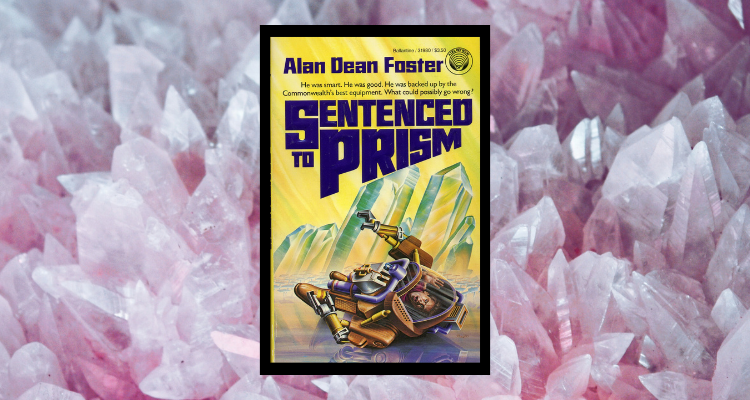|
The planet Earth is home to an immense variety of lifeforms, from the tiniest viruses and microbes up to the huge and complex mammals that roam the land and sea. This teeming glut of life is enormously varied, but in one respect it is monotonously uniform - all life on our planet employs a carbon-based biochemistry. For science fiction writers, the various hypothetical types of biochemistry have long been a source of inspiration. Chief amongst these is the notion that somewhere, on another world, life may have arisen that is based not on carbon but instead on another element with some similar properties: silicon.
Originally published in 1985, Sentenced to Prism is the fifth standalone entry in Alan Dean Foster’s long-running series of SF novels set in his Humanx Commonwealth universe. It represents a novel-length exploration of the idea of silicon-based life. The book depicts a distant planet that is rife with crystalline creatures, and looks into the implications this would have on body type, survival strategies, reproduction, communication, and the nature of intelligence. In classic Foster style, the novel is not only a headlong leap into alternative biology but is also an exciting adventure story about human survival on a bizarre and hostile world.
Sentenced to Prism is set very late in the chronology of Foster’s series; its events occur when the alliance between humans and the insectoid thranx has existed for nearly 600 years. The prehistory of that alliance was recounted in Nor Crystal Tears (1982).
Evan Orgell is a professional “generalist” or troubleshooter working for a powerful corporation, the Aurora Group. Both Orgell and the Group are based on the Commonwealth world of Samstead, which is wracked by frequent hurricanes. Partly as a response to this, the population are highly reliant on high-tech, powered suits which insulate them from the environment and from any potential danger or even discomfort. Orgell is a driven, supremely confident and abrasive figure who is called in by his boss to discuss a covert mission. Orgell is let into a secret: the Aurora Group has discovered a distant planet, which they have named Prism, where silicon-based life is abundant. The potential for commercial exploitation of the planet is huge, but a survey base established there has since gone dark. Despite his lack of off-world experience - he has only visited Earth once before - Orgell readily accepts a mission to travel to Prism in order to explain the loss of communication with the base. He is given a brand-new, highly sophisticated mobile hostile world (MHW) suit, which further increases his confidence. To Orgell, a visit to Prism looks like a fairly simple next step up the corporate ladder. Unfortunately, the reality is very different. On arrival, Orgell discovers that the base has been all but destroyed and almost all of the Aurora Group staff have been gruesomely killed - the others are missing, presumed dead. While searching for the beacons of the missing staff, Orgell is initially protected by his formidable MHW suit. It soon becomes clear, though, that even the Commonwealth’s best technology is no match for Prism. Before long, Orgell is stranded without his suit and exposed to blinding sunlight, countless razor-sharp crystal formations, and deadly flora and fauna - all silicon-based. Orgell is given a chance at survival when, to his shock, he is rescued by an intelligent local lifeform. That creature calls itself A Surface of Fine Azure-Tinted Reflection With Pyroxin Dendritic Inclusions - or reluctantly, Azure for short - and shows Evan that Prism is even more incredible than he realised. Anyone who has enjoyed the earlier Humanx Commonwealth novels is sure to get a lot out of Sentenced to Prism. This fifth standalone book is another exploration of some of Foster’s favourite themes. These include the impact that strange environments would have on alien biology, over-reliance on advanced technology, and discussion of different kinds of intelligence. Foster covers all of these, while also telling an exciting story about Orgell’s quest for survival, and to learn the truth about the fate of the earlier expedition. Once again, Sentenced to Prism is also a book with a message. Orgell begins by believing that he knows just about everything, and that his sophisticated suit can overcome any obstacle. In time, he has to learn the value of humility and open-mindedness; he has to accept that Azure’s bizarre, crystalline people and their strange way of life are just as valid as his own. The novel furthers Foster’s condemnation of “shapeism” that powered previous books, especially Nor Crystal Tears. Evan Orgell may not be the most compelling character, but the book is full of interesting images. Foster’s working through the radical implications of silicon-based life produces some memorable elements, especially creatures that have naturally evolved their own laser weapons. The book recalls Harry Harrison’s classic Deathworld (1960) and Foster’s own Mdworld (1975), in that it depicts what appears to be a totally hostile planet but which can be survivable - if visitors meet it halfway in a spirit not of hostility, but humility.
0 Comments
Your comment will be posted after it is approved.
Leave a Reply. |
About
Exploring classic science fiction, with a focus on the 1950s to the 1990s. Also contributing to Entertainium, where I regularly review new games. Categories
All
|

